 |
|
|
| (Information by Peter Kessler and Edward Dawson, with additional information from The Horse, the Wheel, and Language: How Bronze-Age Riders from the Eurasian Steppes Shaped the Modern World, David W Anthony, from The Iliad, Homer (Translated by E V Rieu, Penguin Books, 1963), from Europe Before History, Kristian Kristiansen, from A Dictionary of Greek and Roman Biography and Mythology, William Smith (Ed), from An Historical Geography of Europe, Norman J G Pounds (Abridged Version), from The Rise of the Greeks, Michael Grant (Charles Scribner's Sons, 1987), from The Early Greeks, R J Hopper (Barnes & Noble Books (NY), 1976), from History of Humanity - Scientific and Cultural Development: From the Third Millennium to the Seventh Century BC (Vol II), Ahmad Hasan Dani, Jean-Pierre Mohen, J L Lorenzo, & V M Masson (Unesco 1996), and from External Links: The Greeks really do have near-mythical origins, ancient DNA reveals (Science), and Phthia (DBpedia).) |
|
|
| fl c.1280s? BC |
Lelex |
King of Lelegia (Laconia). |
The birth of Lelex is traditional ascribed to the gods, and specifically Poseidon or Helios. Whatever oral history preserves his name therefore has not retained his parentage. He is described as a Leleges ruler, a pre-Mycenaean group in Greece. 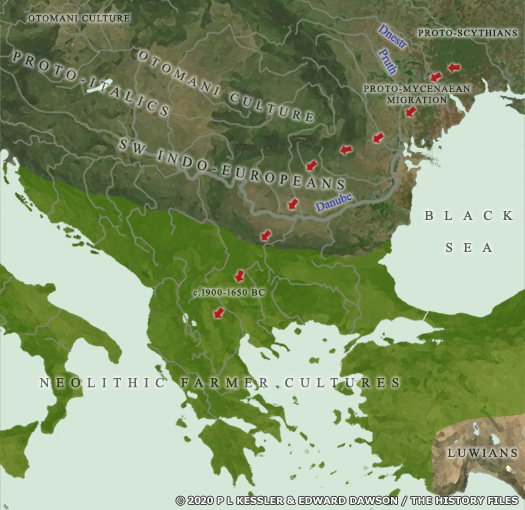 The proto-Mycenaeans seem to have been amongst the last of the western Indo-European _centum_-speakers to take to the road, following a path which had been trodden by related tribes for the past thousand years (click or tap on map to view full sized) The proto-Mycenaeans seem to have been amongst the last of the western Indo-European _centum_-speakers to take to the road, following a path which had been trodden by related tribes for the past thousand years (click or tap on map to view full sized) |
|
|
| fl c.1270s? BC |
Myles |
Son. King of Laconia. |
| fl c.1250s? BC |
Eurotas |
Son. Gave daughter, Sparta, to Lacedaemon. |
| fl c.1240s? BC |
Lacedaemon |
First king of 'Sparta'. Probably a Mycenaean. |
| fl c.1230s? BC |
Amyclas |
Son. Namesake of Amyclae, probable early capital. |
| fl c.1230s? BC |
Argalus |
Son. |
| fl c.1220s? BC |
Cynortes / Cynortas |
Brother. |
| fl c.1220s? BC |
Oebalus / Oibalus |
Son. |
| fl c.1210s BC |
Tyndareus |
Son. Dethroned by his brother. |
| fl c.1210s BC |
Hippocoon |
Brother. Usurper. Killed by Heracles. |
Hippocoon overthrows Tyndareus, a definite mistake as the pair also claim Heracles as a brother. Heracles reinstates Tyndareus and kills Hippocoon and his four sons before going on to have various adventures, not least of which is participation in the Trojan War against the city state of Troy. 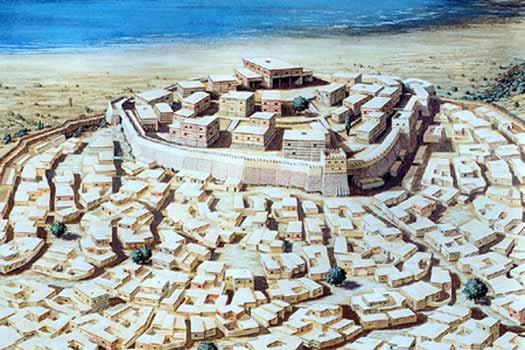 Shown here is an artist's impression of Troy VIh/VIi around 1400 BC, although only the citadel has been excavated properly, with much of the rest of the city's footprint lying beneath mud and still waiting to be rediscovered Shown here is an artist's impression of Troy VIh/VIi around 1400 BC, although only the citadel has been excavated properly, with much of the rest of the city's footprint lying beneath mud and still waiting to be rediscovered |
|
|
| One of his companions, Autolycus, goes on to found the colony of Sinope before joining Jason of Iolkos and his Argonauts. Heracles also subsequently marries Omphale, the [ Atyad](../KingListsMiddEast/AnatoliaLydia.htm#Atyad Maeonia) queen of Maeonia, and goes on to kick-start the [ Heraclid](../KingListsMiddEast/AnatoliaLydia.htm#Heraclid Lydia) dynasty which later rules there. |
|
|
| fl c.1200 BC |
Tyndareus |
Restored by Heracles. Died before or by the Trojan War. |
| fl c.1200 BC |
Heracles / Herakles |
Brother. Later in [ Maeonia](../KingListsMiddEast/AnatoliaLydia.htm#Heraclid Lydia). |
| 1200s BC |
Mycenaean power is gradually eroded by the Dorians who are migrating in from the Balkans, with domination coming by 1140 BC. The surviving Ionic-speaking Mycenaeans gather and flourish in Athens or perhaps in conquered Levantine territories which probably include Phillistia, or in new colonies which have been founded well away from the Dorians. These include Epirus in north-western Greece and Pamphylia in Anatolia, but it also seems likely that Mycenaeans form groups within the Sea Peoples who ravage the eastern Mediterranean in this period. 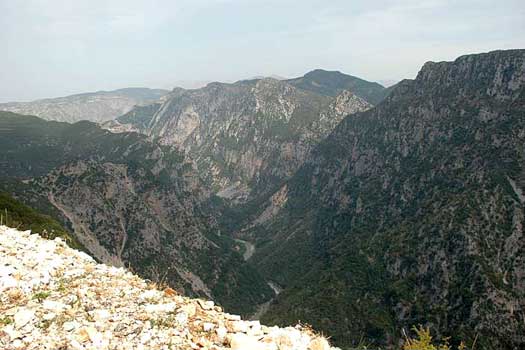 The mountainous landscape of all but coastal Epirus required a hardy inhabitant, and the region's remoteness may have had a bearing on its poorly recorded history in the ancient world The mountainous landscape of all but coastal Epirus required a hardy inhabitant, and the region's remoteness may have had a bearing on its poorly recorded history in the ancient world |
|
All Mycenaean palaces and fortified sites are destroyed and a major proportion of other sites are abandoned. The population of the Peloponnese appears to decline by about seventy-five percent. Mycenae itself remains occupied, but is burned twice in succession and survives in a much-reduced state and size, never again to hold the reins of power. Once the Hittites had been destroyed around 1200 BC, and the Mycenaeans had themselves (probably) smashed Troy, the colonisation of the western coast of Anatolia could begin (the possibility that the earlier Ahhiyawa may also be a Mycenaean colony notwithstanding). This would seem to be the most likely - and popular - avenue of Mycenaean escape from the mainland. Once there they form or take over states or regions such as Caria, Lycia, and [ Maeonia](../KingListsMiddEast/AnatoliaLydia.htm#Heraclid Lydia), and perhaps Pamphylia, between about 1100 to 900 BC. Those states themselves usually survive until they are conquered by the later great empires. 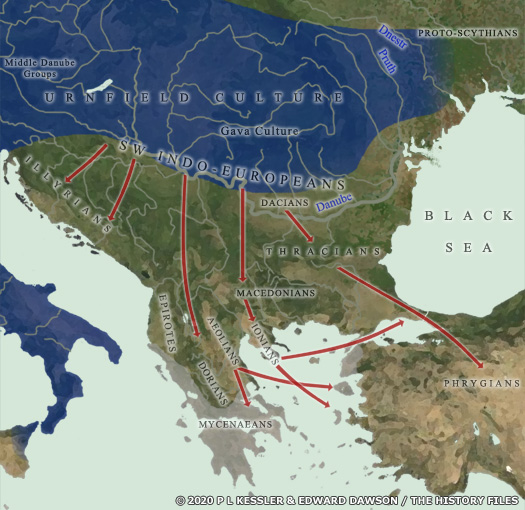 Climate-induced drought in the thirteenth century BC created great instability in the entire eastern Mediterranean region, resulting in mass migration in the Balkans, as well as the fall of city states and kingdoms further east (click or tap on map to view full sized) Climate-induced drought in the thirteenth century BC created great instability in the entire eastern Mediterranean region, resulting in mass migration in the Balkans, as well as the fall of city states and kingdoms further east (click or tap on map to view full sized) |
|
|
| The brothers Agamemnon and Menelaus shelter with Tyndareus following the usurpation of the Mycenaean throne. They marry the king's daughters, Clytemnestra and Helen respectively (the young Helen had been raped by Theseus of Athens when the old king became enraptured by her beauty).Agamemnon wins Helen for his brother in ritual games and with his great wealth, ensuring a double alliance between the two most-powerful Mycenaean states. Both of Tyndareus' sons pre-decease him, so Menelaus becomes his heir. |
|
|
| fl 1193 - 1183 BC |
Menelaus |
Brother of Agamemnon of Mycenae. |
| fl 1193 - 1183 BC |
Helen of Sparta |
Dau of Tyndareus, wife of Menelaus (& Paris & Deiphobus). |
| c.1193 - 1183 BC |
Following the abduction of Helen by Paris of Troy, Agamemnon of Mycenae and his brother gather their supporters together and sail off to the Trojan War. Athens, Crete, Ephyra, Laconia, Phthia, Pylos, Tiryns, and Thebes are all included amongst those allies. 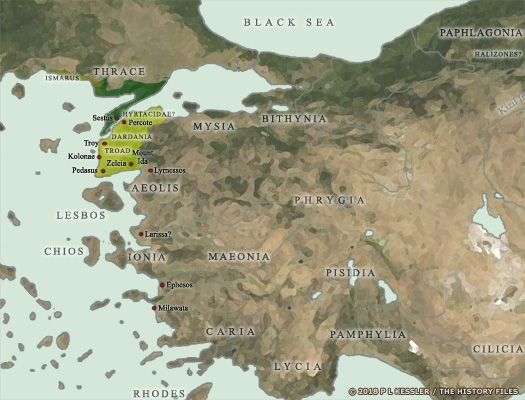 This map of Anatolia is set at the time of the Trojan War, covering the general area of Dardania and the Troad (click or tap on map to view full sized) This map of Anatolia is set at the time of the Trojan War, covering the general area of Dardania and the Troad (click or tap on map to view full sized) |
|
| Menelaus returns with Helen despite her marrying another Trojan after the death of Paris, and she is re-installed as his queen. According to non-Homeric sources, after Menelaus' death his illegitimate son, Megapenthes, sends Helen into exile. |
|
|
| fl c.1170s BC |
Megapenthes |
Son. Likely ruled, but perhaps briefly. |
| fl c.1170s BC |
Orestes |
Son of Menelaus. |
| fl c.1160s? BC |
Hyllus |
Son of Heracles and Deianeira or Melite. |
| fl c.1150s? BC |
Cleodaeus |
Son. Legendary father of Aristomachus. |
| c.1140s BC |
The Dorian invasion from the north takes place between about 1200-1140 BC, with the Mycenaean city states to the north of Sparta falling between those dates, and with domination being achieved by about 1140 BC. Greece enters a dark age lasting about four hundred years. The traditional view of the invasion of the Peloponnese says that approximately eighty years after the Trojan War (in other words, by the end of the century), a group of Dorians joins up with Aetolians to cross the Corinthian Gulf and invade from the north-west. 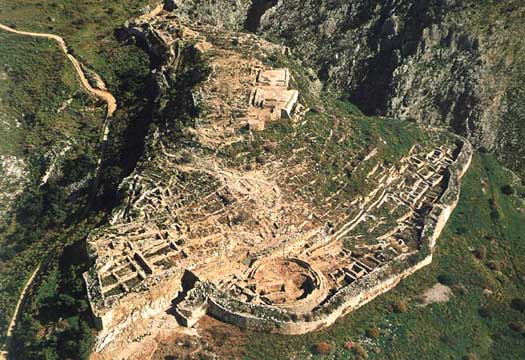 Mycenae was already in ruins by the start of the first millennium AD, having been abandoned during the fall of Mycenaean Greece Mycenae was already in ruins by the start of the first millennium AD, having been abandoned during the fall of Mycenaean Greece |
|
| The Aetolians settle in Elis, and the Dorians divide into two forces, one of which invades and later subdues Messenia, while the other, led by Aristodemus (or his twin sons Eurysthenes and Procles), gains Sparta. They make this the Dorian capital of Laconia. In reality the conquest may be a matter of inroads made over a number of years, and the dates ascribed to the sons of Aristodemus put them about a century and-a-half away from the invasion, so perhaps it is ascribed to them to fill a gap in later knowledge of the event. |
|
|
| fl c.990s? BC |
Aristomachus |
Son. Great-grandson of Heracles, but possibly Dorian. |
| fl c.970 BC |
Temenus |
Son. King of Argos. Legendary father of Caranus of Macedonia. |
Greek myth paints Caranus as the son of Temenus, king of Argos, who in turn is the son of Aristomachus, the Dorian conqueror of Laconia. 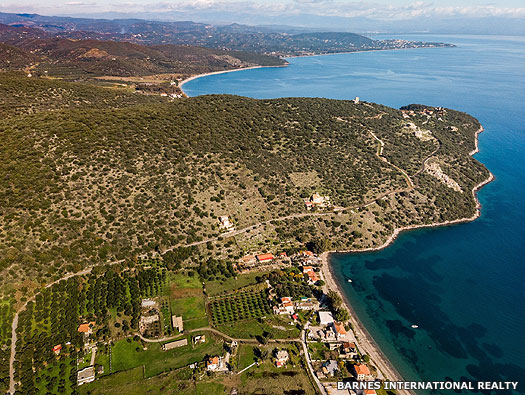 Laconia lies in the southernmost part of the Greek Peloponnese, a beautifully varied modern prefecture and almost like a little country in itself, bounded by the Taygetus mountain range to the west Laconia lies in the southernmost part of the Greek Peloponnese, a beautifully varied modern prefecture and almost like a little country in itself, bounded by the Taygetus mountain range to the west |
|
|
| Given dating discrepancies between Caranus and Aristomachus, it is more likely that he claims descent from the latter rather than being his actual son. It is Caranus who takes his followers north to aid the king of the Orestae and ends up founding the Macedonian kingdom. |
|
|
| c.960 BC |
Aristodemus |
Son of Aristomachus. Also king of Mycenae. |
Aristodemus is instrumental in launching the final attack on Mycenae, which would suggest from his additional title that it is occupied for a time by him, although legend has him being killed before his forces arrive there. Additionally, the two ruling houses of Sparta are created by Aristodemus in the late tenth century BC. A candidate from each house will share the throne. 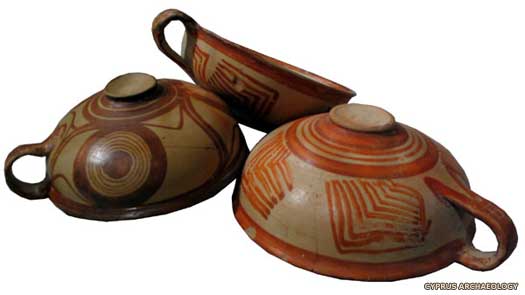 Mycenaean one-handled cups such as these examples appeared on Cyprus during the Late Bronze Age, when Achaean culture dominated parts of the eastern Mediterranean Mycenaean one-handled cups such as these examples appeared on Cyprus during the Late Bronze Age, when Achaean culture dominated parts of the eastern Mediterranean |
|
|
| The idea is that if one of the warlike kings die in battle, the state will not be left leaderless, instead being able to respond immediately to the threat. Classical Sparta is born. |
|
|
|
|
|
Sparta (Greeks) c.950 - 192 BC The Mycenaeans formed several small states during the later second millennium BC. One of those, with its early history largely mythical in nature, was Laconia. This city state was centred on the city of Sparta, named after the wife of its founder, the daughter of Eurotas. Climate-induced drought seriously altered the picture for the Mycenaeans. By the time the Hittites had been destroyed around 1200 BC, and the Mycenaeans had themselves (probably) smashed Troy, the Dorians were already migrating into the region from a disrupted northern Balkans area. Mycenaean power was destroyed and the population of the Peloponnese appeared to decline by about seventy-five percent. The figure of Aristodemus was instrumental in launching the final attack on Mycenae. Additionally though - and most importantly - the two ruling Doric houses of Sparta were created by descendants of his twin sons, seemingly in the late tenth century BC. A candidate from each house would share the Spartan throne. The idea behind it was that if one of the warlike kings died in battle the state would not be left leaderless, instead being able to respond immediately to the threat. Sparta's capital seems not to have been important before about 1000 BC, despite legendary emphasis to the contrary. The nearby remains of sites at Amyclae (a Minoan ruin a few kilometres to the south of Sparta), and Therapne (Therapnae) seem to have been more important, and the latter was probably the Achaean (Mycenaean) capital of Laconia. There are few remaining signs of ancient Sparta. The Spartans set little store on fine buildings and high defensive walls, being far more proud of the fact that their state was protected by men who could fight and defeat any opponent, or die in the attempt.  The numbering for kings was carried down through both houses and not in isolation, although re-used names generally tended to remain within their own house. Kings of the House of Agaid are shown in the centre-left column. Kings of the House of Eurypontidae are in the centre-right column. Some differences in names and dates are shown on some lists, although there is little external evidence for the Spartan kings before around the middle of the sixth century BC (see feature link for a brief run-down of Spartan governmental organisation). Under the Dorians, according to tradition, some hundred independent villages were developed in Laconia and were organised into six kingdoms. The kings of Sparta claimed suzerainty over them all. In the period between about 800-730 BC, according to tradition, Sparta (the city) conquered Laconia (the district) and ruled the towns there through harmostes (regulators or governors). The numbering for kings was carried down through both houses and not in isolation, although re-used names generally tended to remain within their own house. Kings of the House of Agaid are shown in the centre-left column. Kings of the House of Eurypontidae are in the centre-right column. Some differences in names and dates are shown on some lists, although there is little external evidence for the Spartan kings before around the middle of the sixth century BC (see feature link for a brief run-down of Spartan governmental organisation). Under the Dorians, according to tradition, some hundred independent villages were developed in Laconia and were organised into six kingdoms. The kings of Sparta claimed suzerainty over them all. In the period between about 800-730 BC, according to tradition, Sparta (the city) conquered Laconia (the district) and ruled the towns there through harmostes (regulators or governors). |
|
|
 |
|
|
| (Information by Peter Kessler, with additional information from the John De Cleene Archive, from The Iliad, Homer (Translated by E V Rieu, Penguin Books, 1963), from The Histories, Herodotus (Penguin, 1996), from Europe Before History, Kristian Kristiansen, from A Dictionary of Greek and Roman Biography and Mythology, William Smith (Ed), from An Historical Geography of Europe, Norman J G Pounds (Abridged Version), from The Rise of the Greeks, Michael Grant (Charles Scribner's Sons, 1987), from The Early Greeks, R J Hopper (Barnes & Noble Books (NY), 1976), from History of Humanity - Scientific and Cultural Development: From the Third Millennium to the Seventh Century BC (Vol II), Ahmad Hasan Dani, Jean-Pierre Mohen, J L Lorenzo, & V M Masson (Unesco 1996), from Kings of Sparta, John Paul Adams (published online in 2007 but no longer available), from A History of Greece to the Death of Alexander the Great, J B Bury (New York, 1913), and from External Links: The Greeks really do have near-mythical origins, ancient DNA reveals (Science), and Encyclopaedia Iranica.) |
|
|
| House of Agaid |
House of Eurypontidae |
|
| ? - c.930 BC |
Eurysthenes |
Son of Aristodemus of Mycenae, conqueror of Laconia. |
| ? - c.930 BC |
Procles |
Brother. |
Eventually the Doric Laconians come to resent the Minyans (descendants of the Argonauts) who have settled in their midst. Theras (a ninth generation descendant of Cadmus of Thebes) promises to lead the Minyans out of Laconia. 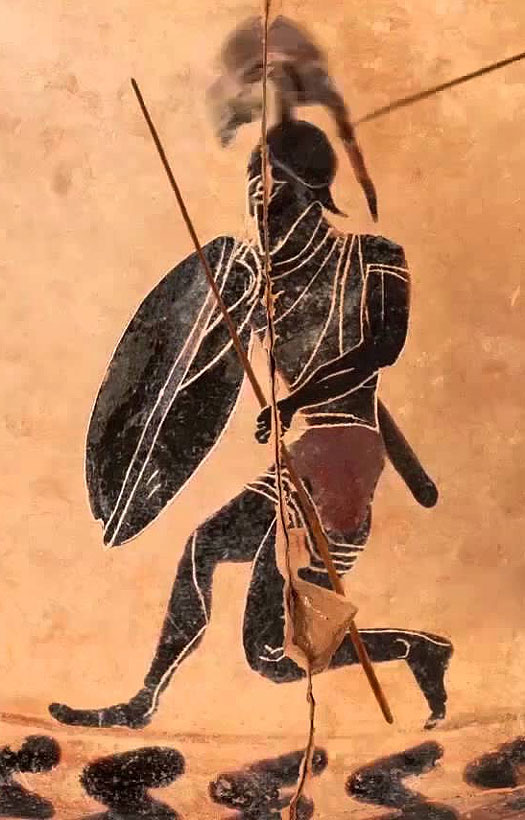 According to mythology the first king of the Minyans was Minyas, of the ancient city of 'Almonia' in Thessaly, while speculation has Almonia later being renamed to Iolklos, the city from which Jason launched his expedition with the Argonauts According to mythology the first king of the Minyans was Minyas, of the ancient city of 'Almonia' in Thessaly, while speculation has Almonia later being renamed to Iolklos, the city from which Jason launched his expedition with the Argonauts |
|
|
| Eurysthenes and Procles allow them to leave. When Theras arrives on Calliste the people there welcome him as a descendant of Cadmus and give him the kingship. He changes the island's name to Thera. |
|
|
| ? - c.895 BC |
Sous/Soos |
Son of Procles. |
| c.930 - 900? BC |
Agis |
Son of Eurysthenes. Founder of the House of Agaid. |
According to Pausanias, Agis is the founder of the Agids or Agidae. He is claimed as being the son and successor of Eurysthenes. The slightly later Eurypon (see below), founder of the Eurypontids, is the successor of Procles. The list of kings which begins with Agis and Eurypon is generally considered as being historical. Agis is also traditionally credited with capturing Helos, a maritime town which resists his attempt to curtail its guaranteed rights (although this event is also ascribed to Alcamenes (circa 740-700 BC)). From this he creates the class of serfs called helots which provides the backbone of service and support for the Spartan warrior class. These helots have been claimed as native Pelasgians who are now subjugated. 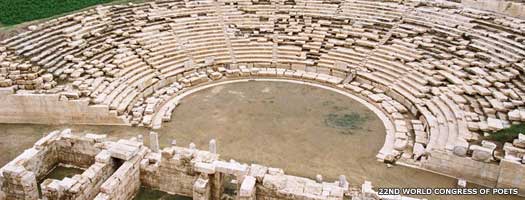 The ruins of the third century BC theatre of Larissa are not Pelasgian as such, as there is little remaining which could categorically be attributed to them The ruins of the third century BC theatre of Larissa are not Pelasgian as such, as there is little remaining which could categorically be attributed to them |
|
|
| c.900 - 870? BC |
Echestratus |
Son of Agis. |
| c.895 - 865? BC |
Eurypon |
Son of Sous. Founder of the House of Eurypontidae. |
| In the first half of the ninth century the first hostilities take place between Argos and Sparta. Pausanias states that the ninth century kings of Sparta campaign in Cynouria, along the eastern Peloponnesian coast. Fighting continues under Leobatas and Prytanis. |
|
|
| c.870 - 840? BC |
Leobatas / Labotas |
Son of Echestratus. |
| c.865 - 835? BC |
Prytanis |
Son of Eurypon? |
| c.840 - 815? BC |
Doryssus / Doriagus |
Son of Leobatas. |
| c.835 - 805? BC |
Polydectes |
Son of Prytanis? |
| c.815 - 785? BC |
Agesilaus I |
Son of Doryssus. |
| c.805 - 775? BC |
Eunomus |
Son of Polydectes? |
| c.785 - 760 BC |
Archelaus |
Son of Agesilaus. |
| c.775 - 750 BC |
Charillus |
Grandson of Eunomus. Purported to have invaded Argolis. |
| c.760 - 740 BC |
Teleclus |
Son of Archelaus. Killed in skirmish with Messenians. |
The reign of Teleclus sees the Spartans conquer Amyclae (the old Laconian capital), Pharis, and Geranthrae, towns belonging to the Perioeci or 'dwellers round about'. This secures them the central Laconian plain. 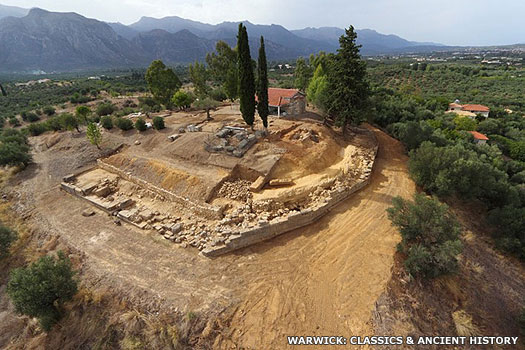 The sanctuary of Apollo Amyklaios lies on the hill of Agia Kyriaki in Amyclae, Sparta, although the modern village of Sklavokhori is thought to be its location due to inscriptions found at the site - disputed, however, as Sklavokhori is more than twice the claimed distance from Sparta The sanctuary of Apollo Amyklaios lies on the hill of Agia Kyriaki in Amyclae, Sparta, although the modern village of Sklavokhori is thought to be its location due to inscriptions found at the site - disputed, however, as Sklavokhori is more than twice the claimed distance from Sparta |
|
|
| In a period in which the institution of the ephors (overseers) is claimed as having been formed, Teleclus is killed during a skirmish with the Messenians during a festival at the temple of Artemis Limnatis, an event which leads to the First Messenian War. |
|
|
| c.750 - 720 BC |
Nicander |
Son of Charillus. |
| c.735 - 720 BC |
During the First Messenian War, Sparta subjugates its neighbour, Messenia, after a fifteen year struggle. Many Messenians are reduced to the status of helots, the servant class which maintains the warrior elite for much of Sparta's history. |
|
| c.740 - 700 BC |
Alcamenes |
Son of Teleclus. Conquered the helots? |
| c.720 - 675 BC |
Theopompus |
Son of Nicander. Involved in formation of the ephors? |
| 706 BC |
The only Spartan colony outside Greece is founded. Located on the heel ofItaly, it is named Taras (later Tarentum, modern Taranto). The colonists interact with the local tribes, including the Peucetii, over whom the Spartans may exert some control. The westernmost neighbours of the Peucetii, the Messapii, oppose the settlement, and they and the Spartans frequently find themselves in conflict. 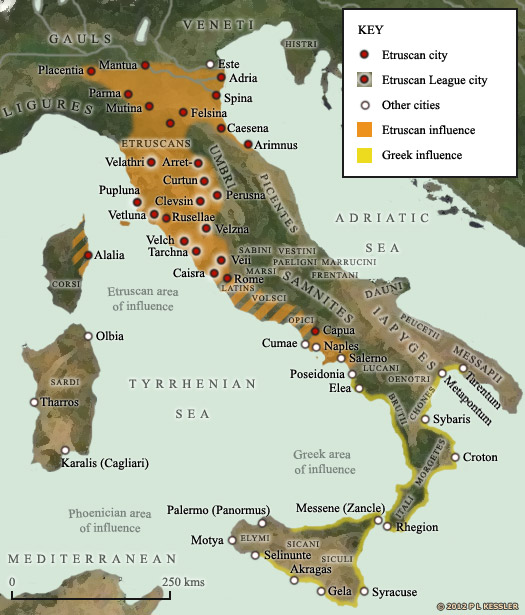 This map shows not only the greatest extent of Etruscan influence in Italy, during the seventh to fifth centuries BC, including the Campania region to the south (click or tap on map to view on a separate page) This map shows not only the greatest extent of Etruscan influence in Italy, during the seventh to fifth centuries BC, including the Campania region to the south (click or tap on map to view on a separate page) |
|
| c.700 - 665 BC |
Polydorus |
Son of Alcamenes. |
| c.675 - 660 BC |
Anaxandridas I |
Son of Theopompus. Circa 675-645 BC on some lists. |
| c.665 - 640 BC |
Eurycrates |
Son of Polydorus. |
| c.660 - 645 BC |
Archidamus I |
Son of Zeuxidamas. Circa 600-575 BC on some lists. |
| c.648 - 631 BC |
The Messenians revolt and, in the Second Messenian War, they manage to keep Sparta at bay for seventeen years until Spartan skill at arms defeats them, most especially after an eleven year siege of the stronghold of Ira (or Eira) and final defeat at the Battle of the Great Foss. |
|
| c.645 - 625 BC |
Anaxilas |
Son of Archidamus. Some lists have Zeuxidamas here. |
| c.640 - 615 BC |
Anaxander |
Son of Eurycrates. |
| c.625 - 600 BC |
Leotychidas I |
Son of Hippocratidas? Some lists have Anaxidamus. |
| c.615 - 590 BC |
Eurycratidas |
Son of Anaxander. |
Sparta suffers during a devastating war with the Greek state of Tegea, with no victor on either side. The long-standing hostility between the two states is believed to date from the reign of Charillis (circa 775-750 BC). 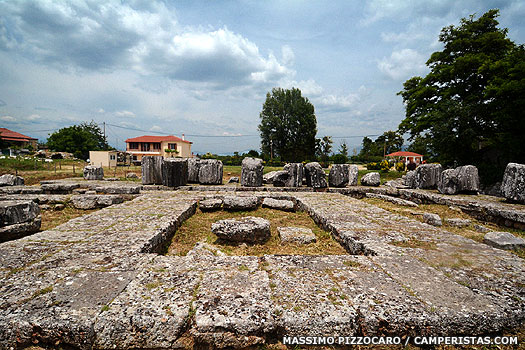 The city of Tegea lay to the east of Arcadia, traditionally founded by Aleus and a check on Spartan expansion until about 550 BC The city of Tegea lay to the east of Arcadia, traditionally founded by Aleus and a check on Spartan expansion until about 550 BC |
|
|
| c.600 - 575 BC |
Hippocratidas |
Replaced by Archidamus II (c.675-660 BC) on some lists. |
| c.590 - 560 BC |
Leon / Lindius |
Son of Eurycratidas. |
| 582 |
Psammitichos of Corinth is assassinated by Sparta, bringing the period of Corinthian tyrants to an end. An oligarchic republic is formed in the city which sees a few powerful families rule there. |
|
| Under Leon, the Spartans fight to a draw with Tegea while, according to Pausanias, around this time Argos expels the population of the coastal town of Nauplia. In the following years, Sparta declares a policy of protecting other Peloponnesian states from such encroachment. It offers the Nauplians the chance to settle in the town of Mothone in Messenia. |
|
|
| c.575 - 550 BC |
Agasicles |
Son of Archidamus I. |
| c.560 - 520 BC |
Anaxandridas II |
Son of Leon. |
| 556 - 555 BC |
Sparta intervenes to depose Aischines, tyrant of Sicyon who is expelled along with the rest of the family of Cleisthenes (his predecessor). In 555 Sparta probably liberates Phlious and Megara of their tyrants. 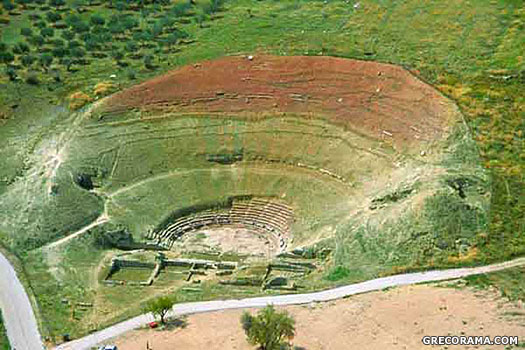 Sicyon was founded by the Mycenaeans, located on the northern Peloponnese about eighteen kilometres to the north-west of Corinth and later invaded by Dorians Sicyon was founded by the Mycenaeans, located on the northern Peloponnese about eighteen kilometres to the north-west of Corinth and later invaded by Dorians |
|
| c.554 BC |
Anaxandridas finally brings about a Spartan defeat of Tegea, forcing its leaders to acknowledge Sparta as its overlord. Sparta is established as a major regional power, now abandoning a policy of violent conquest in favour of one of diplomacy which eventually results in the formation of the Peloponnesian League. |
|
| c.550 - 515 BC |
Ariston |
Son of Agasicles. |
| c.520 - 490 BC |
Cleomenes I |
Son of Anaxandridas. Schemed to replace Demaratus as king. |
| c.515 - 491 BC |
Demaratus |
Son of Ariston, but questionable parentage. In Pergamum. |
| c.490 - 480 BC |
Leonidas I |
Half brother of Cleomenes I. m Gorgo, dau of Cleomenes I. |
| 480 - 479 BC |
 Leonidas achieves everlasting fame as a result of the events in the Battle of Thermopylae against the Persians in 480 BC (see feature link). The 300 Spartans of Leonidas' personal guard leads a force totalling no more than seven thousand Greeks which includes [Athenians](GreeceAthensGreeks.htm#Elected Archons Classical), Corinthians, Helots, Mycenaeans, Thebans, and Thespians. The Persian army is held up long enough for the Athenians to prepare their navy for a seaborne engagement with the Persian fleet. (These events are depicted somewhat colourfully - but no less impressively for that - in the 2007 film, 300, and its sequel.) Leonidas achieves everlasting fame as a result of the events in the Battle of Thermopylae against the Persians in 480 BC (see feature link). The 300 Spartans of Leonidas' personal guard leads a force totalling no more than seven thousand Greeks which includes [Athenians](GreeceAthensGreeks.htm#Elected Archons Classical), Corinthians, Helots, Mycenaeans, Thebans, and Thespians. The Persian army is held up long enough for the Athenians to prepare their navy for a seaborne engagement with the Persian fleet. (These events are depicted somewhat colourfully - but no less impressively for that - in the 2007 film, 300, and its sequel.) 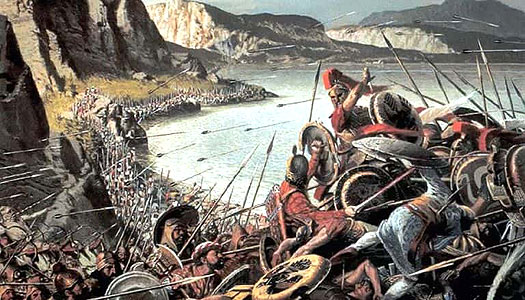 The Spartan stand at Thermopylae in 480 BC, along with some Greek allies, stopped the Persian advance in its tracks and provided a rallying call for the rest of the free Greek cities to oppose the Persians The Spartan stand at Thermopylae in 480 BC, along with some Greek allies, stopped the Persian advance in its tracks and provided a rallying call for the rest of the free Greek cities to oppose the Persians |
|
Athens, as the leader of the coalition of city states known as the Delian League, fights the Persian navy at the battles of Artemisium and Salamis, the latter being a resounding Greek victory. It leaves much of the Persian navy destroyed and Xerxes is forced to retreat to Asia, leaving his army in Greece under Mardonius (with the naval battles being shown to superb graphic effect in the 2014 sequel film, 300: Rise of an Empire, although it does contain a great many historical inaccuracies). As a reward for his support of Xerxes during the war, the exiled Demaratus of Sparta is granted a satrapy of his own in Pergamum, whilst Queen Artemisia I of Halicarnassus in Karkâ is sent to Ephesus to care for the sons of Xerxes (not quite the doomed warrior queen of the 300 sequel). In the following year Mardonius meets the Greeks in a final battle. The Spartans, now at full strength, lead a pan-Greek army at the Battle of Plataea in 479 BC which decisively defeats the Persians and ends the Greco-Persian War. 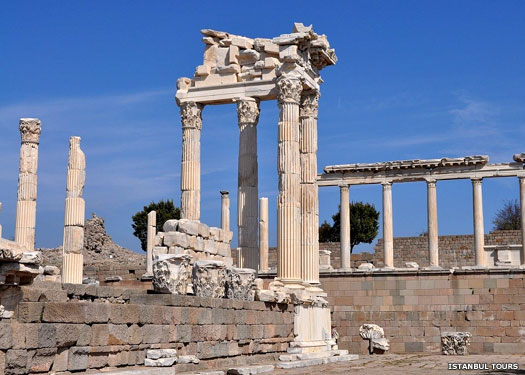 Pergamon rose to prominence during the years of division in the Greek empire following the death of Alexander the Great in 323 BC when his empire was divided among his generals - now it worked in tandem with Cappadocia Pergamon rose to prominence during the years of division in the Greek empire following the death of Alexander the Great in 323 BC when his empire was divided among his generals - now it worked in tandem with Cappadocia |
|
|
| 491 - 476 BC |
Leotychidas II |
Leotychidas I on some lists. Gained throne through Cleomenes. |
| 480 - 458 BC |
Pleistarchus |
Son of Leonidas I. |
| 473 BC |
Hoping to follow up on a victory of 500 BC, the Spartan settlers of Tarentum (modern Taranto) and its ally, Rhegion (modern Reggio Calabria), in Italy attempt to take control of one or more of the towns of the Messapii and Peucetii. However, the tribal Italians are able to hold them off, and in this year inflict a serious defeat upon the Greeks, thanks to the superiority of their cavalry (according to Herodotus). The war against Tarentum continues until 467 BC. |
|
| 469 - 427? BC |
Archidamus II |
Grandson of Leotychidas II. Regent (476-469)? Died 427/6. |
| 468 - 458 BC |
The Third Messenian War is sparked by a helot revolt following the massive earthquake of 464 BC, which had caused the Spartans heavy losses. The helots fortify themselves at Ithome and Sparta calls in help from its allies, including [Athens](GreeceAthensGreeks.htm#Elected Archons Classical), which delivers siege equipment. However, Sparta experiences self-doubt at its enslavement of an entire Greek people, the Messenias, and sends the Athenians home. This causes a rift which leads to two wars, in 460 BC and 431 BC. Sparta eventually negotiates a settlement with the Messenians. 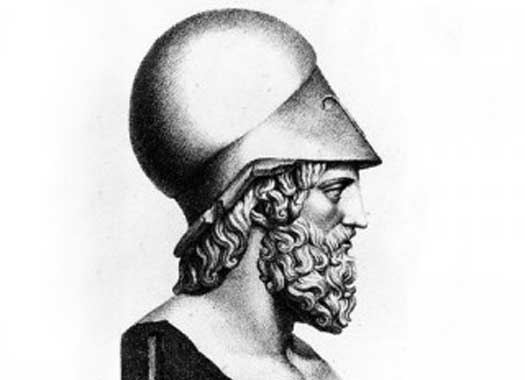 The Athenian politician and general Themistocles (archon in 493-492 BC) helped build up the city's navy so that it was a force to be reckoned with when the Persians invaded Greece - and thanks to this, Athenian Admiral Cimon was able to defeat the Persians on the banks of the River Eurymedon in Pamphylia in 465 BC The Athenian politician and general Themistocles (archon in 493-492 BC) helped build up the city's navy so that it was a force to be reckoned with when the Persians invaded Greece - and thanks to this, Athenian Admiral Cimon was able to defeat the Persians on the banks of the River Eurymedon in Pamphylia in 465 BC |
|
| 458 - 408 BC |
Pleistoanax |
Cousin of Pleistarchus. Exiled 446-428 BC. |
| 460 - c.445 BC |
Pleistoanax advocates peace during the First Peloponnesian War. In 446 BC he is charged by the Spartans with taking a bribe, probably from Pericles of [Athens](GreeceAthensGreeks.htm#Elected Archons Classical), to withdraw from the plain of Eleusis in Attica after leading the Peloponnesian forces there following the revolts of Euboea and Megara from the Athenian empire, and is exiled. His father is regent in his stead. In fact, Pericles had probably been offering good peace terms. In 428 BC, Pleistoanax is recalled and restored in obedience to the advice of the Delphic oracle. |
|
| 431 - 404 BC |
The Second Peloponnesian War pitches Sparta against [Athens](GreeceAthensGreeks.htm#Elected Archons Classical) in all-out war. Fortunes swing either way, but Athens' failure to take the Corinthian colony of Syracuse and the subsequent loss of thousands of troops almost brings the city and its empire to its knees. A year later and Sparta's acquisition of Persian gold sees the Athenian fleet starved of huge numbers of freelance rowers and soldiers, giving Sparta dominance both on land and, for the first time, at sea. Athens is defeated and Sparta is established as the greatest Greek power. 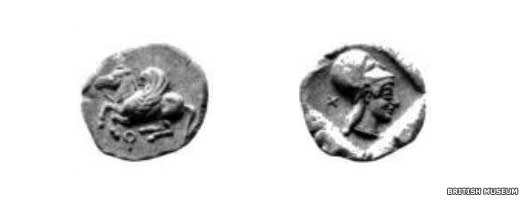 This rather indistinct photo shows two sides of a Corinthian coin which was minted in the fifth century BC, a time of momentous events for Greece This rather indistinct photo shows two sides of a Corinthian coin which was minted in the fifth century BC, a time of momentous events for Greece |
|
| 427 - 399 BC |
Agis II |
Son of Archidamus II. Ruled until 401/400 BC on some lists. |
| 408 - 395 BC |
Pausanias |
Father of Pleistoanax. Brother of Leonidas. Regent 446-428. |
| 395 - 387 BC |
At the start of the Corinthian War, Pausanias fails to join forces with the Spartan general, Lysander, and for this is condemned to death and replaced as king by his son Agesipolis I. Pausanias escapes to exile in Tegea. He also travels to the Persian empire and marries a Persian princess. At some point he returns to Sparta and is killed by the populace. Sparta fights the war against a coalition of four allied states: Thebes, [Athens](GreeceAthensGreeks.htm#Elected Archons Classical), Corinth, and Argos, all initially backed by Persia. |
|
| 399 - 360 BC |
Agesilaus II |
Half-brother of Agis II. Ousted Agis' possibly illegitimate son. |
| 395 - 380 BC |
Agesipolis I |
Son of Pausanias. |
| 380 - 371 BC |
Cleombrotus I |
Brother. Little is known of his early life. |
| 371 BC |
The number of Spartan warriors has fallen dramatically from its heyday at the time of Thermopylae, when perhaps ten thousand true Spartans could be called to battle. 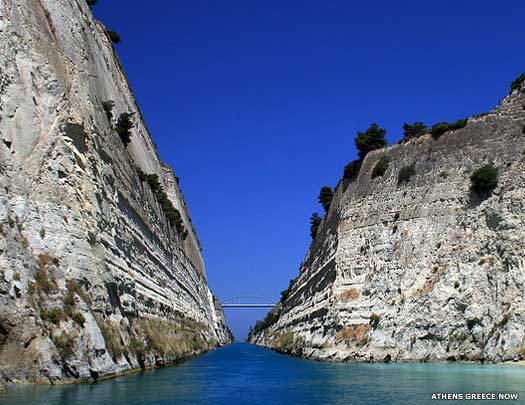 Construction of the Corinth canal was started during the Classical period before being abandoned, while the modern version seen here was only completed in 1883 Construction of the Corinth canal was started during the Classical period before being abandoned, while the modern version seen here was only completed in 1883 |
|
| Now the number is more like a thousand, and Sparta's warriors become a sort of officer class, leading allied and subject troops to battle, something which works nearly as well as the old Spartan war machine. In an effort to solve the problem of post-Peloponnesian War conflicts, a pan-Greek conference is called in 371 BC. However, the arrogant Agesilaus II picks a fight with Thebes. Cleombrotus leads the allied Spartan-Peloponnesian army of about seven hundred Spartans and thirteen hundred allies (some reluctant) against a Theban army three times their number under Epaminondas at the Battle of Leuctra. Cleombrotus' death and the utter defeat of his army leads to the helots being freed and Spartan dominance in Greece being ended forever. |
|
|
| 371 - 370 BC |
Agesipolis II |
Son. |
| 370 - 309 BC |
Cleomenes II |
Brother. |
| 362 BC |
Ariobarzanus, satrap of Phrygia, and Datames, satrap of Khilakku and Katpatuka, are in revolt against Persian King Artaxerxes II. Autophradates, satrap of Sparda, has been ordered to suppress the rebellion and he has already managed to expel Ariobarzanes from the greater part of his satrapy. 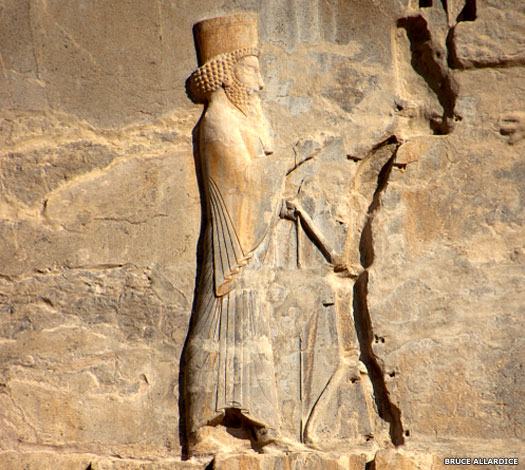 Artaxerxes II of Persia is immortalised in relief at the entry to his tomb in Persepolis, having survived a reign which began with a series of revolts and included war against the troublesome Greeks (External Link: Creative Commons Licence 2.0 Generic) Artaxerxes II of Persia is immortalised in relief at the entry to his tomb in Persepolis, having survived a reign which began with a series of revolts and included war against the troublesome Greeks (External Link: Creative Commons Licence 2.0 Generic) |
|
| Now Sparta, and also Takhôs, pharaoh of [ Egypt](../KingListsAfrica/EgyptAncient%5FLatePeriod.htm#30th Dynasty), send substantial help to the rebels. Two years later, in 360 BC, Ariobarzanes is betrayed by his son, Mithridates, and is executed. |
|
|
| 360 - 338 BC |
Archidamus III |
Son of Agesilaus II. |
| 338 BC |
Philip II of Macedonia defeats the Greek states at the Battle of Chaeronea and gains overlordship over all of Greece. [Athens](GreeceAthensGreeks.htm#Elected Archons Classical) and other city states (but not Sparta) join the Corinthian League (or Hellenic League) which is formed by Phillip to unify the military forces at his command so that he can pressure Persia. |
|
| 338 - 331 BC |
Agis III |
Son. Killed by Antipater of [Macedonia](GreeceMacedonia.htm#Great Kings) after a rebellion. |
| 331 BC |
A Spartan defeat by [Macedonia](GreeceMacedonia.htm#Great Kings) at the Battle Megalopolis forces them to join the Corinthian League. It is Antipater, regent for Alexander 'the Great' who carries out the successful Macedonian attack while his master is campaigning in Mesopotamia. 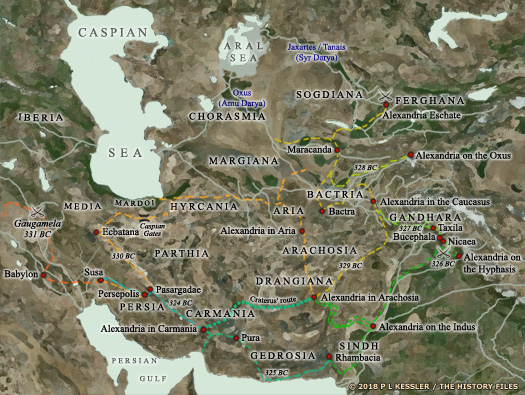 The route of Alexander's ongoing campaigns are shown in this map, with them leading him from Europe to Egypt, into Persia, and across the vastness of eastern Iran as far as the Pamir mountain range (click or tap on map to view full sized) The route of Alexander's ongoing campaigns are shown in this map, with them leading him from Europe to Egypt, into Persia, and across the vastness of eastern Iran as far as the Pamir mountain range (click or tap on map to view full sized) |
|
| 331 - c.305 BC |
Eudamidas I |
Brother. |
| 309 - 265 BC |
Areus I |
Grandson of Cleomenes II. |
| c.305 - 275 BC |
Archidamus IV |
Son of Eudamidas I. Defeated by Macedonia in 296 BC. |
| 303/302 BC |
Prince Cleonymus is the son of the late Cleomenes II and the uncle of Areus I. His own position as a claimant to the throne is less impressive, having been rejected for kingship due to his violent nature. Now he leads a mercenary fleet up the Adriatic, intent on sacking the city of Patavium (its later Latin name, possibly Venetic Patav, today's Padua). The Veneti successfully destroy and capture the Spartan ships before any attack can be launched. Cleonymus survives the failure. |
|
| c.275 - 244 BC |
Eudamidas II |
Son. |
| 265 BC |
Areus dies in battle near Corinth during the Chremonidean War (267-261 BC), which is fought between a coalition of Greek city states including [Athens](GreeceAthensGreeks.htm#Elected Archons Classical) and Sparta for the restoration of their independence from Macedonian influence, aided by the Ptolemaic Egyptians. 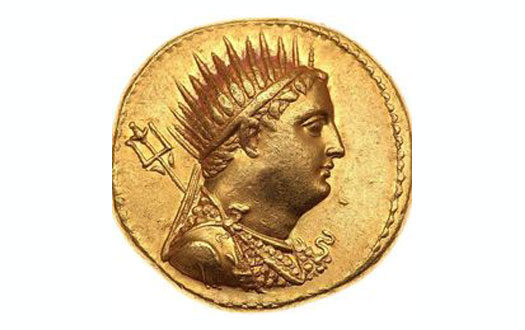 Ptolemy Euergetes increased Egyptian imperial borders at the expense of Seleucid Syria, something which few of his successors were ever able to manage Ptolemy Euergetes increased Egyptian imperial borders at the expense of Seleucid Syria, something which few of his successors were ever able to manage |
|
| 265 - 262 BC |
Acrotatus |
Son of Areus I. |
| 262 - 254 BC |
Areus II |
Son. |
| 254 - 235 BC |
Leonidas II |
Grandson of Cleomenes II. |
| c.243 - 241 BC |
The ephor (elected officials who helped the kings govern), Lysander, claims to see a sign from the gods against Leonidas and the king flees to avoid a trial. In his absence, Leonidas is deposed and replaced by his son-in-law, Cleombrotus, who opposes the attempted reforms of his co-regent, Agis IV. |
|
| 244 - 241 BC |
Agis IV |
Son of Eudamidas II. Murdered. |
| c.243 - 241 BC |
Cleombrotus II |
Not on all lists. Son-in-law & reigned during Leonidas' exile. |
| 241 - c.228 BC |
Eudamidas III |
Son of Agis IV. Succeeded by his uncle. |
| 235 - 222 BC |
Cleomenes III |
Son of Cleombrotus II. Fled to Egypt. In exile (222-219 BC). |
| c.228 - 227 BC |
Archidamus V |
Removed and possibly killed by Cleomenes III. |
| 227 - 219 BC |
Cleomenes III is a great reformer of social conditions in Sparta following the example set by Agis IV, although in 227 BC he removes his political opposition in a coup. This includes Archidamus V and the entire office of the ephor (with four dead and eighty exiled). Eucleidas is installed as his co-ruler. 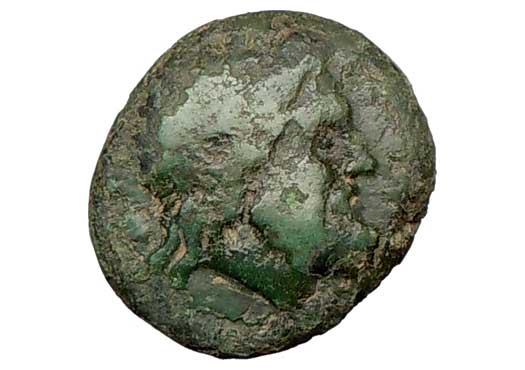 Shown here is the obverse side of a coin which shows the face of Macedonian king, Antigonus II Gonatas, who seized Macedonia during its moment of weakness and created a prosperous and largely settled reign during a big slice of the third century BC Shown here is the obverse side of a coin which shows the face of Macedonian king, Antigonus II Gonatas, who seized Macedonia during its moment of weakness and created a prosperous and largely settled reign during a big slice of the third century BC |
|
| For his last campaign in 222 BC, he faces 28,000 Macedonians with ten thousand Spartans at the Battle of Sellasia but, despite good positioning and fighting, his forces are overwhelmed. He takes refuge at Alexandria in Egypt with Ptolemy Euergetes, but is arrested by his successor in 219 BC. He escapes, tries to raise a revolt which fails, and to avoid capture he takes his own life. With him perishes Sparta's last hope of recovering her ancient supremacy in Greece. |
|
|
| c.227 - 222 BC |
Eucleidas |
Agid brother of Cleomenes III. |
| 222 - 219 BC |
Following the death of Cleomenes III, the Spartan system begins to disintegrate and from 221-219 BC the defeated kingdom is instead governed as a republic under Brachyllas the Boetian. |
|
| 221 - 219 BC |
Brachyllas |
Boetian governor appointed by Antigonus III of Macedonia . |
| 219 - 215 BC |
Agesipolis III |
Not on all lists. Grandson of Cleombrotus III. Deposed. |
| 219 - 215 BC |
Lycurgus |
Heritage obscure. Ended the joint kingship. |
| 215 BC |
Lycurgus ends the joint kingship by deposing Agesipolis III and not replacing him with another Agid king. From this point onwards, the House of Eurypontidae rules Sparta alone with a series of cruel and rapacious kings. 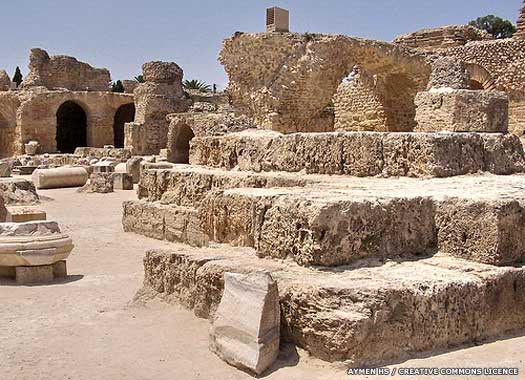 The city of Carthage existed in its original glory for at least four hundred and twenty-eight years before it was destroyed by the Romans - and possibly another two centuries before that as a developing colony which was founded by Phoenicians The city of Carthage existed in its original glory for at least four hundred and twenty-eight years before it was destroyed by the Romans - and possibly another two centuries before that as a developing colony which was founded by Phoenicians |
|
| During the Second Punic War which starts in this year, Philip V of Macedonia allies himself to Carthage. To avoid a possible reinforcement of Hannibal by Macedonia, Rome dispatches a force to tie down the Macedonians in the First Macedonian War (211-206 BC) Even though it is only a minor conflict, it opens the way for later Roman military intervention in Greece. |
|
|
| 215 - 210 BC |
Lycurgus |
Former joint king and now first sole king. |
| 210 - 207 BC |
Machanidas / Machinidas |
Guardian of Pelops. A tyrant. Opposed by Pelops. |
| 210 - 206 BC |
Pelops |
Son of Lycurgus. Last king from the two houses. |
| 206 BC |
The Achaean League routs the Aetolians and Sparta. Philip V of Macedonia recaptures all other lands which the Aetolians had previously captured. Machanidas is dead. Nabis becomes the new regent and tyrant, deposing Pelops and, after the young prince's mysterious death, declares himself king. 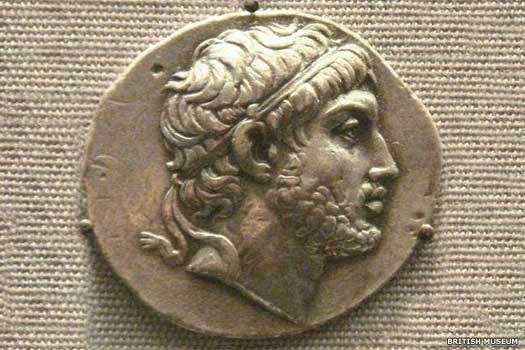 This silver tetradrachm bears the head of Philip V of Macedonia, one of its great later kings but one who was also the cause of Roman intervention This silver tetradrachm bears the head of Philip V of Macedonia, one of its great later kings but one who was also the cause of Roman intervention |
|
| 206 - 192 BC |
Nabis |
Descendant of Demaratus. Usurper. Assassinated. |
| 201 - 195 BC |
The Achaean League again routs the forces of Sparta. During Rome's Second Macedonian War of 200-197 BC, Nabis changes sides in favour of the Romans. However, he has poor relations with the Roman general, T Quinctius Flamininus and, in 195 BC, Flamininus is helped by the Macedonians to fight against Nabis. |
|
| 192 BC |
Nabis has claimed to be a descendant of Demaratus (circa 515-491 BC), the Spartan king who had been exiled and who had then sided with the Persians to be awarded a satrapy in Pergamum. His attempts to restore Spartan power in the region have not been covered in glory and he is assassinated. |
|
| 192 BC |
Laconicus |
Of royal blood, relationship unknown. Last king of Sparta. |
| 192 BC |
An army is now dispatched by the Achaean League to force Sparta to join it. The generally obscure Laconicus is removed from any pretence at holding power, bringing the kingdom to an end. 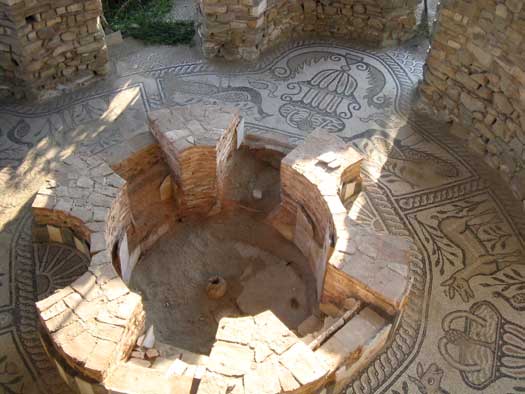 Shown here are the ruins of the Roman forum at Stobi in what is now North Macedonia (known for some time as the 'Former Yugoslav Republic of Macedonia' (FYROM)) Shown here are the ruins of the Roman forum at Stobi in what is now North Macedonia (known for some time as the 'Former Yugoslav Republic of Macedonia' (FYROM)) |
|
| 146 BC |
The Achaean League is dissolved by a now-powerful Roman republic following the similar dismantling of the kingdom of Macedonia by 150 BC. Greece is now annexed to the Roman province of 'Macedonia and Thrace'. |
|
 |
|
|

 The proto-Mycenaeans seem to have been amongst the last of the western Indo-European _centum_-speakers to take to the road, following a path which had been trodden by related tribes for the past thousand years (click or tap on map to view full sized)
The proto-Mycenaeans seem to have been amongst the last of the western Indo-European _centum_-speakers to take to the road, following a path which had been trodden by related tribes for the past thousand years (click or tap on map to view full sized) Shown here is an artist's impression of Troy VIh/VIi around 1400 BC, although only the citadel has been excavated properly, with much of the rest of the city's footprint lying beneath mud and still waiting to be rediscovered
Shown here is an artist's impression of Troy VIh/VIi around 1400 BC, although only the citadel has been excavated properly, with much of the rest of the city's footprint lying beneath mud and still waiting to be rediscovered The mountainous landscape of all but coastal Epirus required a hardy inhabitant, and the region's remoteness may have had a bearing on its poorly recorded history in the ancient world
The mountainous landscape of all but coastal Epirus required a hardy inhabitant, and the region's remoteness may have had a bearing on its poorly recorded history in the ancient world Climate-induced drought in the thirteenth century BC created great instability in the entire eastern Mediterranean region, resulting in mass migration in the Balkans, as well as the fall of city states and kingdoms further east (click or tap on map to view full sized)
Climate-induced drought in the thirteenth century BC created great instability in the entire eastern Mediterranean region, resulting in mass migration in the Balkans, as well as the fall of city states and kingdoms further east (click or tap on map to view full sized) This map of Anatolia is set at the time of the Trojan War, covering the general area of Dardania and the Troad (click or tap on map to view full sized)
This map of Anatolia is set at the time of the Trojan War, covering the general area of Dardania and the Troad (click or tap on map to view full sized) Mycenae was already in ruins by the start of the first millennium AD, having been abandoned during the fall of Mycenaean Greece
Mycenae was already in ruins by the start of the first millennium AD, having been abandoned during the fall of Mycenaean Greece Laconia lies in the southernmost part of the Greek Peloponnese, a beautifully varied modern prefecture and almost like a little country in itself, bounded by the Taygetus mountain range to the west
Laconia lies in the southernmost part of the Greek Peloponnese, a beautifully varied modern prefecture and almost like a little country in itself, bounded by the Taygetus mountain range to the west Mycenaean one-handled cups such as these examples appeared on Cyprus during the Late Bronze Age, when Achaean culture dominated parts of the eastern Mediterranean
Mycenaean one-handled cups such as these examples appeared on Cyprus during the Late Bronze Age, when Achaean culture dominated parts of the eastern Mediterranean The numbering for kings was carried down through both houses and not in isolation, although re-used names generally tended to remain within their own house. Kings of the House of Agaid are shown in the centre-left column. Kings of the House of Eurypontidae are in the centre-right column. Some differences in names and dates are shown on some lists, although there is little external evidence for the Spartan kings before around the middle of the sixth century BC (see feature link for a brief run-down of Spartan governmental organisation). Under the Dorians, according to tradition, some hundred independent villages were developed in Laconia and were organised into six kingdoms. The kings of Sparta claimed suzerainty over them all. In the period between about 800-730 BC, according to tradition, Sparta (the city) conquered Laconia (the district) and ruled the towns there through harmostes (regulators or governors).
The numbering for kings was carried down through both houses and not in isolation, although re-used names generally tended to remain within their own house. Kings of the House of Agaid are shown in the centre-left column. Kings of the House of Eurypontidae are in the centre-right column. Some differences in names and dates are shown on some lists, although there is little external evidence for the Spartan kings before around the middle of the sixth century BC (see feature link for a brief run-down of Spartan governmental organisation). Under the Dorians, according to tradition, some hundred independent villages were developed in Laconia and were organised into six kingdoms. The kings of Sparta claimed suzerainty over them all. In the period between about 800-730 BC, according to tradition, Sparta (the city) conquered Laconia (the district) and ruled the towns there through harmostes (regulators or governors).
 According to mythology the first king of the Minyans was Minyas, of the ancient city of 'Almonia' in Thessaly, while speculation has Almonia later being renamed to Iolklos, the city from which Jason launched his expedition with the Argonauts
According to mythology the first king of the Minyans was Minyas, of the ancient city of 'Almonia' in Thessaly, while speculation has Almonia later being renamed to Iolklos, the city from which Jason launched his expedition with the Argonauts The ruins of the third century BC theatre of Larissa are not Pelasgian as such, as there is little remaining which could categorically be attributed to them
The ruins of the third century BC theatre of Larissa are not Pelasgian as such, as there is little remaining which could categorically be attributed to them The sanctuary of Apollo Amyklaios lies on the hill of Agia Kyriaki in Amyclae, Sparta, although the modern village of Sklavokhori is thought to be its location due to inscriptions found at the site - disputed, however, as Sklavokhori is more than twice the claimed distance from Sparta
The sanctuary of Apollo Amyklaios lies on the hill of Agia Kyriaki in Amyclae, Sparta, although the modern village of Sklavokhori is thought to be its location due to inscriptions found at the site - disputed, however, as Sklavokhori is more than twice the claimed distance from Sparta This map shows not only the greatest extent of Etruscan influence in Italy, during the seventh to fifth centuries BC, including the Campania region to the south (click or tap on map to view on a separate page)
This map shows not only the greatest extent of Etruscan influence in Italy, during the seventh to fifth centuries BC, including the Campania region to the south (click or tap on map to view on a separate page) The city of Tegea lay to the east of Arcadia, traditionally founded by Aleus and a check on Spartan expansion until about 550 BC
The city of Tegea lay to the east of Arcadia, traditionally founded by Aleus and a check on Spartan expansion until about 550 BC Sicyon was founded by the Mycenaeans, located on the northern Peloponnese about eighteen kilometres to the north-west of Corinth and later invaded by Dorians
Sicyon was founded by the Mycenaeans, located on the northern Peloponnese about eighteen kilometres to the north-west of Corinth and later invaded by Dorians Leonidas achieves everlasting fame as a result of the events in the Battle of Thermopylae against the Persians in 480 BC (see feature link). The 300 Spartans of Leonidas' personal guard leads a force totalling no more than seven thousand Greeks which includes [Athenians](GreeceAthensGreeks.htm#Elected Archons Classical), Corinthians, Helots, Mycenaeans, Thebans, and Thespians. The Persian army is held up long enough for the Athenians to prepare their navy for a seaborne engagement with the Persian fleet. (These events are depicted somewhat colourfully - but no less impressively for that - in the 2007 film, 300, and its sequel.)
Leonidas achieves everlasting fame as a result of the events in the Battle of Thermopylae against the Persians in 480 BC (see feature link). The 300 Spartans of Leonidas' personal guard leads a force totalling no more than seven thousand Greeks which includes [Athenians](GreeceAthensGreeks.htm#Elected Archons Classical), Corinthians, Helots, Mycenaeans, Thebans, and Thespians. The Persian army is held up long enough for the Athenians to prepare their navy for a seaborne engagement with the Persian fleet. (These events are depicted somewhat colourfully - but no less impressively for that - in the 2007 film, 300, and its sequel.)  The Spartan stand at Thermopylae in 480 BC, along with some Greek allies, stopped the Persian advance in its tracks and provided a rallying call for the rest of the free Greek cities to oppose the Persians
The Spartan stand at Thermopylae in 480 BC, along with some Greek allies, stopped the Persian advance in its tracks and provided a rallying call for the rest of the free Greek cities to oppose the Persians Pergamon rose to prominence during the years of division in the Greek empire following the death of Alexander the Great in 323 BC when his empire was divided among his generals - now it worked in tandem with Cappadocia
Pergamon rose to prominence during the years of division in the Greek empire following the death of Alexander the Great in 323 BC when his empire was divided among his generals - now it worked in tandem with Cappadocia The Athenian politician and general Themistocles (archon in 493-492 BC) helped build up the city's navy so that it was a force to be reckoned with when the Persians invaded Greece - and thanks to this, Athenian Admiral Cimon was able to defeat the Persians on the banks of the River Eurymedon in Pamphylia in 465 BC
The Athenian politician and general Themistocles (archon in 493-492 BC) helped build up the city's navy so that it was a force to be reckoned with when the Persians invaded Greece - and thanks to this, Athenian Admiral Cimon was able to defeat the Persians on the banks of the River Eurymedon in Pamphylia in 465 BC This rather indistinct photo shows two sides of a Corinthian coin which was minted in the fifth century BC, a time of momentous events for Greece
This rather indistinct photo shows two sides of a Corinthian coin which was minted in the fifth century BC, a time of momentous events for Greece Construction of the Corinth canal was started during the Classical period before being abandoned, while the modern version seen here was only completed in 1883
Construction of the Corinth canal was started during the Classical period before being abandoned, while the modern version seen here was only completed in 1883 Artaxerxes II of Persia is immortalised in relief at the entry to his tomb in Persepolis, having survived a reign which began with a series of revolts and included war against the troublesome Greeks (External Link: Creative Commons Licence 2.0 Generic)
Artaxerxes II of Persia is immortalised in relief at the entry to his tomb in Persepolis, having survived a reign which began with a series of revolts and included war against the troublesome Greeks (External Link: Creative Commons Licence 2.0 Generic) The route of Alexander's ongoing campaigns are shown in this map, with them leading him from Europe to Egypt, into Persia, and across the vastness of eastern Iran as far as the Pamir mountain range (click or tap on map to view full sized)
The route of Alexander's ongoing campaigns are shown in this map, with them leading him from Europe to Egypt, into Persia, and across the vastness of eastern Iran as far as the Pamir mountain range (click or tap on map to view full sized) Ptolemy Euergetes increased Egyptian imperial borders at the expense of Seleucid Syria, something which few of his successors were ever able to manage
Ptolemy Euergetes increased Egyptian imperial borders at the expense of Seleucid Syria, something which few of his successors were ever able to manage Shown here is the obverse side of a coin which shows the face of Macedonian king, Antigonus II Gonatas, who seized Macedonia during its moment of weakness and created a prosperous and largely settled reign during a big slice of the third century BC
Shown here is the obverse side of a coin which shows the face of Macedonian king, Antigonus II Gonatas, who seized Macedonia during its moment of weakness and created a prosperous and largely settled reign during a big slice of the third century BC The city of Carthage existed in its original glory for at least four hundred and twenty-eight years before it was destroyed by the Romans - and possibly another two centuries before that as a developing colony which was founded by Phoenicians
The city of Carthage existed in its original glory for at least four hundred and twenty-eight years before it was destroyed by the Romans - and possibly another two centuries before that as a developing colony which was founded by Phoenicians This silver tetradrachm bears the head of Philip V of Macedonia, one of its great later kings but one who was also the cause of Roman intervention
This silver tetradrachm bears the head of Philip V of Macedonia, one of its great later kings but one who was also the cause of Roman intervention Shown here are the ruins of the Roman forum at Stobi in what is now North Macedonia (known for some time as the 'Former Yugoslav Republic of Macedonia' (FYROM))
Shown here are the ruins of the Roman forum at Stobi in what is now North Macedonia (known for some time as the 'Former Yugoslav Republic of Macedonia' (FYROM))